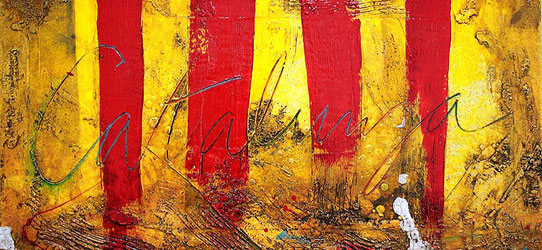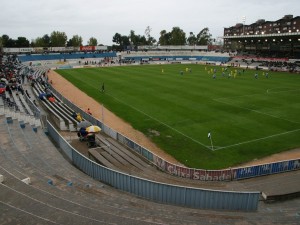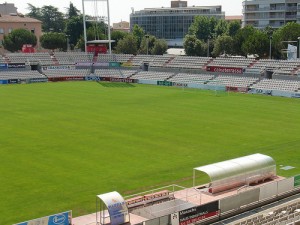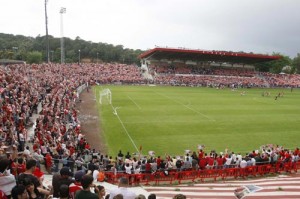Catalunya’s Hidden Gems: Sabadell, Terrassa and Girona
-
Updated: 9 March, 2012

Think Catalunya and too many people don’t look beyond Barcelona’s city limits. Rent yourself a car or hop on a train and you will discover that the region has a whole lot more to offer. That also applies to the football fan, and after exploring the stadiums in and around Barcelona, this week we are going to spread our wings a little further.
Around half an hour north of the Catalan capital is Sabadell, which was once at the heart of Catalunya’s industrial revolution, but today it is a rather unremarkable commercial city, and certainly not on the main tourist trail. However, it is home to La Segunda’s Centre d’Esports Sabadell Futbol Club, who can rightfully claim to be the third biggest club in Catalunya. They have played a total of 14 seasons in La Primera and even qualified for European football in the late 1960’s. Their home, the Estadi de la Nova Creu Alta dates from 1967 and is just to the west of the city centre and close to the Parc de Catalunya.

Nearly 45 years old, Nova Creu Alta still looks fresh and impressive. It has been helped by a couple of make-overs, the most significant coming in advance of the 1992 Barcelona Olympics, when additional seating and media facilities were added. The ground hosted six matches during the Olympiad, but none of them came near to testing the 20,000 capacity, with Mexico’s match with Ghana having the highest attendance of 6,000. The main stand was re-roofed in 2010 and the slightly curved ends were given a lick of paint to create the clubs distinctive quarters pattern on the steps. Opposite the main stand is a bank of seats, and like the main stand this is slightly cranked. It’s a credit to Sabadell’s Municipal Council that the stadium looks so well-tended, when others of a similar age look tired or have fallen into a state of disrepair.
Five miles west of Sabadell is Terrassa, an eternal commercial rival, but one whose football club, Terrassa Futbol Club has consistently underachieved. They play at the Estadi Olímpic de Terrassa, which as the name suggests, is another stadium that massively benefited from the 1992 Summer Olympics. However, it is a little ironic given Terrassa’s lack of footballing pedigree, that the stadium held the finals of the hockey tournament, rather than any football. Terrassa FC has fallen on hard times and currently resides in the Tercera, but it has played 15 seasons in the second division, the last as recently as 2004-05.

The Estadi Olímpic de Terrassa is also worth a look and you will find it to the north of the city, in the middle of the municipality’s impressive Ciudad Deportiva. Originally conceived in 1960, the stadium was completely refurbished in 1992 when the existing terraces were refaced and seats installed on all four sides of the ground. Over the west side, the rather basic short pitched roof was replaced with a huge 130 metre long cantilevered structure. The roof follows the curve of the seating and at 22 metres deep, provides good cover for the seats on all three levels. The grass pitch was replaced with AstroTurf and new floodlights were installed on corner rigs that lean toward the pitch on rigs that resemble parallel bars. The artificial pitch has since been replaced with natural turf, but it is all a little too bland for my taste, and would benefit from having its 11,000 beige seats, changed into the red of its home club.
Our final destination is Girona, around an hour east of Sabadell and culturally a major improvement on anything that our two previous stops have to offer. Girona stands high on a fortified hill above the Rio Onyar and it is said that the city has witnessed a battle in every century since the Romans first built the fortress of Gerunda two millennia ago. Nowadays, the nearest the locals get to a skirmish is a trip to the Estadi de Montilivi, home of Girona Fútbol Club. After years in the wilderness, Girona FC is experiencing something of a renaissance, currently in its fourth season back in La Segunda, after a fifty year absence.

The Estadi de Montilivi is close to the city’s university around a mile south east of the city centre, and you’d be right in thinking that it looks more than a little familiar. Typical of many builds of this era, it features a concrete cantilevered stand, around 60 metres length and a single tier of terracing around the rest of the pitch. It is almost identical in style, if not size to Sabadell’s Nova Creu Alta, and was officially opened on 14 August 1970. The return to La Segunda meant that the stadium required a major re-fit. Seats were installed on the north and south terraces and the main stand was also refurbished with new seats, changing rooms and media facilities. The east terrace was however beyond saving and it took until June 2010 for it to be rebuilt, raising the capacity to a modest 9,282. Montilivi is pretty standard 1970’s fayre, but at least it has been saved from falling in to further disorder.
Next week we complete our travels around Catalunya with a trip to the west of the region, with a look at the stadiums in Lleida, Reus and Tarragona.



You must be logged in to post a comment Login